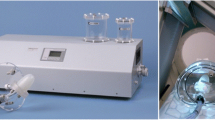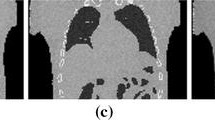Abstract
A realistic 3-D gated cardiac phantom with known left ventricular (LV) volumes and ejection fractions (EFs) was produced to evaluate quantitative measurements obtained from gated myocardial single-photon emission tomography (SPET). The 3-D gated cardiac phantom was designed and constructed to fit into the Data Spectrum anthropomorphic torso phantom. Flexible silicone membranes form the inner and outer walls of the simulated left ventricle. Simulated LV volumes can be varied within the range 45–200 ml. The LV volume curve has a smooth and realistic clinical shape that is produced by a specially shaped cam connected to a piston. A fixed 70-ml stroke volume is applied for EF measurements. An ECG signal is produced at maximum LV filling by a controller unit connected to the pump. This gated cardiac phantom will be referred to as the Amsterdam 3-D gated cardiac phantom, or, in short, the AGATE cardiac phantom. SPET data were acquired with a triple-head SPET system. Data were reconstructed using filtered back-projection following pre-filtering and further processed with the Quantitative Gated SPECT (QGS) software to determine LV volume and EF values. Ungated studies were performed to measure LV volumes ranging from 45 ml to 200 ml. The QGS-determined LV volumes were systematically underestimated. For different LV combinations, the stroke volumes measured were consistent at 60–61 ml for 8-frame studies and 63–65 ml for 16-frame studies. QGS-determined EF values were slightly overestimated between 1.25% EF units for 8-frame studies and 3.25% EF units for 16-frame studies. In conclusion, the AGATE cardiac phantom offers possibilities for quality control, testing and validation of the whole gated cardiac SPET sequence, and testing of different acquisition and processing parameters and software.






Similar content being viewed by others
References
Bateman TM, Berman DS, Heller GV, Brown KA, Cerqueira MD, Verani MS, Udelson JE. American Society of Nuclear Cardiology position statement on electrocardiographic gating of myocardial perfusion SPECT scintigrams. J Nucl Cardiol 1999; 6:470–471.
Berman DS, Germano G, Shaw LJ. The role of nuclear cardiology in clinical decision making. Semin Nucl Med 1999; 29:280–297.
Mansoor MR, Heller GV. Gated SPECT imaging. Semin Nucl Med 1999; 29:271–278.
Germano G, Kiat H, Kavanagh PB, Moriel M, Mazzanti M, Su HT, Van Train KF, Berman DS. Automatic quantification of ejection fraction from gated myocardial perfusion SPECT. J Nucl Med 1995; 36:2138–2147.
Williams KA, Taillon LA. Left ventricular function in patients with coronary artery disease assessed by gated tomographic myocardial perfusion images. Comparison with assessment by contrast ventriculography and first-pass radionuclide angiography. J Am Coll Cardiol 1996; 27:173–181.
Yoshioka J, Hasegawa S, Yamaguchi H, Tokita N, Paul AK, Xiuli M, Maruyama A, Hori M, Nishimura T. Left ventricular volumes and ejection fraction calculated from quantitative electrocardiographic-gated 99mTc-tetrofosmin myocardial SPECT. J Nucl Med 1999; 40:1693–1698.
Calnon DA, Kastner RJ, Smith WH, Segalla D, Beller GA, Watson DD. Validation of a new counts-based gated single photon emission computed tomography method for quantifying left ventricular systolic function: comparison with equilibrium radionuclide angiography. J Nucl Cardiol 1997; 4:464–471.
Yang KT, Chen HD. Evaluation of global and regional left ventricular function using technetium-99m sestamibi ECG-gated single-photon emission tomography. Eur J Nucl Med 1998; 25:515–521.
Nakajima K, Higuchi T, Taki J, Kawano M, Tonami N. Accuracy of ventricular volume and ejection fraction measured by gated myocardial SPECT: comparison of 4 software programs. J Nucl Med 2001; 42:1571–1578.
Vallejo E, Dione DP, Bruni WL, Constable RT, Borek PP, Soares JP, Carr JG, Condos SG, Wackers FJ, Sinusas AJ. Reproducibility and accuracy of gated SPECT for determination of left ventricular volumes and ejection fraction: experimental validation using MRI. J Nucl Med 2000; 41:874–882.
Bax JJ, Lamb H, Dibbets P, Pelikan H, Boersma E, Viergever EP, Germano G, Vliegen HW, de Roos A, Pauwels EK, Van der Wall EE. Comparison of gated single-photon emission computed tomography with magnetic resonance imaging for evaluation of left ventricular function in ischemic cardiomyopathy. Am J Cardiol 2000; 86:1299–1305.
Nichols K, Lefkowitz D, Faber T, Folks R, Cooke D, Garcia EV, Yao SS, DePuey EG, Rozanski A. Echocardiographic validation of gated SPECT ventricular function measurements. J Nucl Med 2000; 41:1308–1314.
Rees MR, Parkin V, Wilde P. The use of gated perfusion scanning in the assessment of left ventricular volume. Eur J Radiol 2001; 38:200–204.
Ritchie JL, Larsson S, Israelson A, Schnell PO, Holmgren A, Williams DL, Thorell JI. Single photon tomographic imaging of a standard heart phantom with 201T1: a gamma camera based system. Eur J Nucl Med 1982; 7:254–259.
Udelson JE, Fares MA. How accurate is quantitative gated SPECT? J Nucl Med 2000; 41:883–886.
Fidler V, Fettich J, Prepadnik M. Study of myocardial regional wall motion parameter’s accuracy by software perfusion phantom. Nucl Med Commun 1992; 13:461–463.
Achtert AD, King MA, Dahlberg ST, Pretorius PH, LaCroix KJ, Tsui BM. An investigation of the estimation of ejection fractions and cardiac volumes by a quantitative gated SPECT software package in simulated gated SPECT images. J Nucl Cardiol 1998; 5:144–152.
Pretorius PH, King MA, Tsui BM, LaCroix KJ, Xia W. A mathematical model of motion of the heart for use in generating source and attenuation maps for simulating emission imaging. Med Phys 1999; 26:2323–2332.
Nakajima K, Taki J, Higuchi T, Kawano M, Taniguchi M, Maruhashi K, Sakazume S, Tonami N. Gated SPET quantification of small hearts: mathematical simulation and clinical application. Eur J Nucl Med 2000; 27:1372–1379.
Feigenbaum H. Echocardiography. Philadelphia: Lea and Febiger, 1986.
Everaert H, Franken PR, Flamen P, Goris M, Momen A, Bossuyt A. Left ventricular ejection fraction from gated SPET myocardial perfusion studies: a method based on the radial distribution of count rate density across the myocardial wall. Eur J Nucl Med 1996; 23:1628–1633.
Smith WH, Kastner RJ, Calnon DA, Segalla D, Beller GA, Watson DD. Quantitative gated single photon emission computed tomography imaging: a counts-based method for display and measurement of regional and global ventricular systolic function. J Nucl Cardiol 1997; 4:451–463.
Faber TL, Cooke CD, Folks RD, Vansant JP, Nichols KJ, DePuey EG, Pettigrew RI, Garcia EV. Left ventricular function and perfusion from gated SPECT perfusion images: an integrated method. J Nucl Med 1999; 40:650–659.
Liu YH, Sinusas AJ, DeMan P, Zaret BL, Wackers FJ. Quantification of SPECT myocardial perfusion images: methodology and validation of the Yale-CQ method. J Nucl Cardiol 1999; 6:190–204.
Silbernagl, S, Despopoulos, A. Taschenatlas der Physiologie. Stuttgart: Georg Thieme, 1979.
Kubo N, Morita K, Katoh C, Shiga T, Konno M, Tsukamoto E, Morita Y, Tamaki N. A new dynamic myocardial phantom for the assessment of left ventricular function by gated single-photon emission tomography. Eur J Nucl Med 2000; 27:1525–1530.
Kirven D, Jaszczak RJ, Tsui BM, Perry.T.W. Dynamic cardiac beating phantom. J Nucl Med 2001; 42:165P.
Dynamic Cardiac Phantom, Data Spectrum Corporation, USA
Acknowledgements
The authors are indebted to Remco Knol for creating the figures.
Author information
Authors and Affiliations
Corresponding author
Additional information
An erratum to this article can be found at http://dx.doi.org/10.1007/s00259-004-1609-7
Addendum
Addendum
The AGATE cardiac phantom is custom made, in collaboration between the Departments of Nuclear Medicine and Medical Technological Development, Academic Medical Center, Amsterdam, The Netherlands. It does not come with a CE certificate. Responsibility for the phantom’s use lies with the user. Information on availability and costs of the AGATE cardiac phantom can be obtained by contacting the corresponding author of this paper (E. Busemann Sokole).
Rights and permissions
About this article
Cite this article
Visser, J.J.N., Busemann Sokole, E., Verberne, H.J. et al. A realistic 3-D gated cardiac phantom for quality control of gated myocardial perfusion SPET: the Amsterdam gated (AGATE) cardiac phantom. Eur J Nucl Med Mol Imaging 31, 222–228 (2004). https://doi.org/10.1007/s00259-003-1352-5
Received:
Accepted:
Published:
Issue Date:
DOI: https://doi.org/10.1007/s00259-003-1352-5




